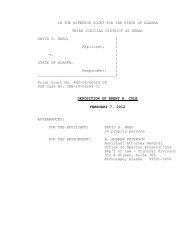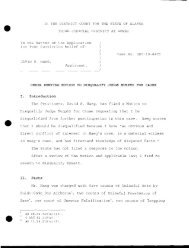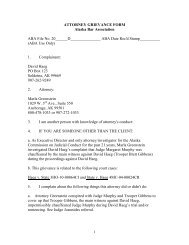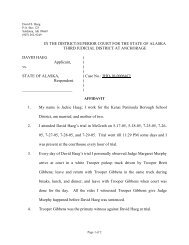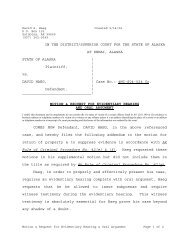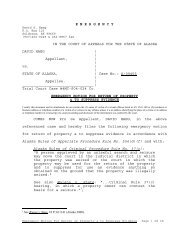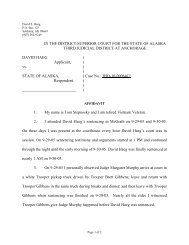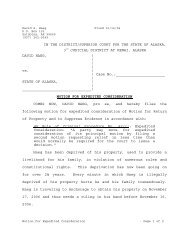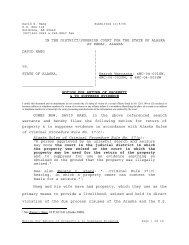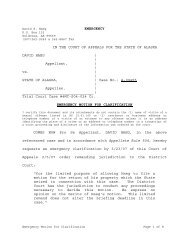PCR Exhibits - Alaska State of Corruption
PCR Exhibits - Alaska State of Corruption
PCR Exhibits - Alaska State of Corruption
You also want an ePaper? Increase the reach of your titles
YUMPU automatically turns print PDFs into web optimized ePapers that Google loves.
Gibbens was notified <strong>of</strong> this report, he suspected that the information was inaccurate. The<br />
coordinates that Haeg and Zellers gave placed the kill site just within unit 19D-East. But Gibbens<br />
knew that the wolves in the pack then frequenting that area were predominately black, with only<br />
two that might be considered gray.<br />
On March 11, 2004, Gibbens inspected the reported kill site. He found wolf tracks but no<br />
kill site near the reported location. In addition to this discrepancy, Gibbens recalled that on the<br />
day <strong>of</strong> the reported kills, when he was <strong>of</strong>f-duty, he had seen Haeg’s distinctive airplane. The<br />
airplane was a mile or two outside <strong>of</strong> unit 19D-East and was flying away from that unit. To<br />
Gibbens, it appeared that the pilot was following a fresh wolf track.<br />
On March 21, Gibbens met and spoke to Haeg and Zellers when they returned to<br />
McGrath to seal the three wolf hides. While Haeg refueled his airplane, Gibbens and Haeg talked<br />
about the airplane’s skis and its oversized tail wheel. Gibbens noticed that the airplane’s skis and<br />
its oversized tail wheel would leave a distinctive track when it landed in snow. Gibbens and<br />
Zellers discussed the weapons and the shotgun ammunition that Zellers was using to shoot the<br />
wolves. This ammunition was a relatively this meeting, Haeg said that he knew the boundaries <strong>of</strong><br />
the area where he was allowed to take wolves under the predator control program.<br />
On March 26, while flying his airplane, Gibbens spotted wolf tracks from a large pack <strong>of</strong><br />
wolves on the Swift River. He also saw where another airplane had landed to examine the track<br />
and determine the wolves’ direction <strong>of</strong> travel. Because his airplane was low on fuel, Gibbens<br />
continued home. The next day, he returned to investigate. From the air, he confirmed that the<br />
area was not a trap site or kill site. He then followed the wolf tracks up the Swift River and found<br />
where wolves had killed a moose on an island in the river. The island was covered with heavy<br />
brush and had numerous wolf trails. Gibbens saw that someone had set snares and leg traps on<br />
the island.<br />
Gibbens followed the wolf tracks further upriver. About a half mile away from the moose<br />
kill, he saw where a wolf had been killed. It looked like the wolf had been shot from the air, and<br />
there was a set <strong>of</strong> airplane tracks that had taxied over the wolf kill site. He continued to follow<br />
the wolf tracks up the Swift River and found three more places where wolves had been shot from<br />
the air. He saw evidence that the wolf carcasses had been picked up and placed in an airplane,<br />
and he saw a staging area nearby where the airplane had landed several times.<br />
These kill sites were all about forty to fifty-five miles from the nearest boundary <strong>of</strong> unit<br />
19D-East. There was no evidence near these sites <strong>of</strong> snaring or trapping, nor <strong>of</strong> any ground<br />
transportation like a snow machine. Rather, the evidence indicated that an airplane had landed<br />
near the kill sites and that someone had gotten out <strong>of</strong> the airplane, approached the wolf carcasses,<br />
and hauled them back to the airplane. The airplane tracks at the kill sites and at the staging area<br />
appeared to be the same. Gibbens recognized that they were similar to Haeg’s airplane’s<br />
distinctive ski and tail wheel arrangement.<br />
With the help <strong>of</strong> other troopers, Gibbens more thoroughly investigated the kill sites. The<br />
troopers found shotgun pellets that were consistent with the type <strong>of</strong> buckshot Haeg and Zellers<br />
275



